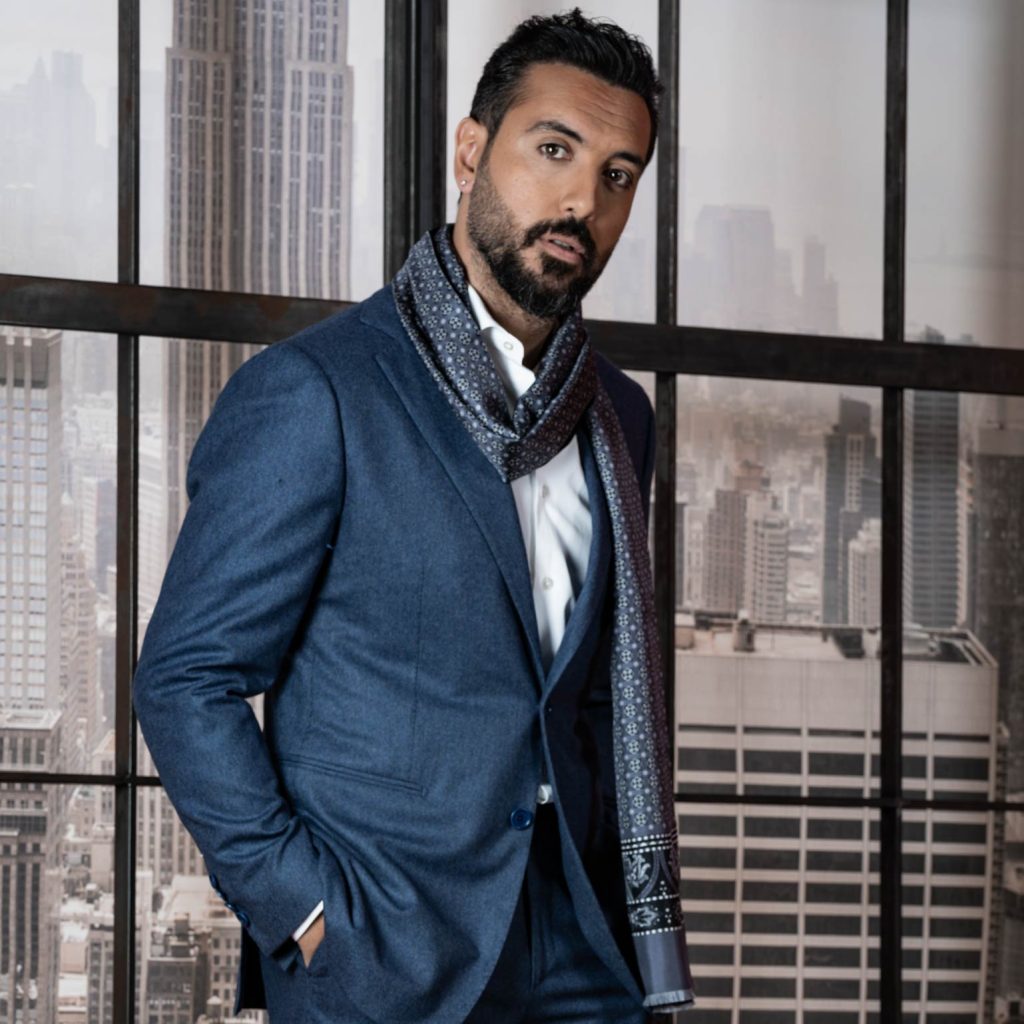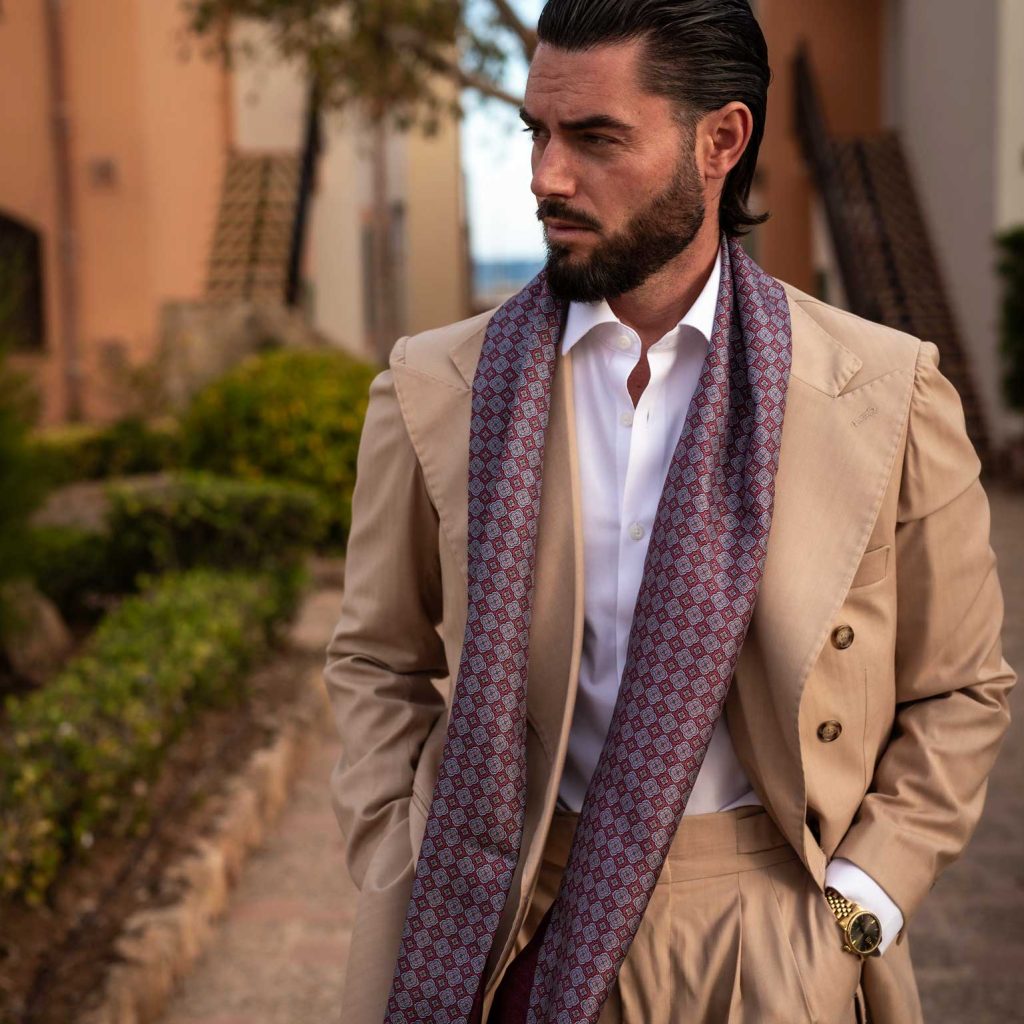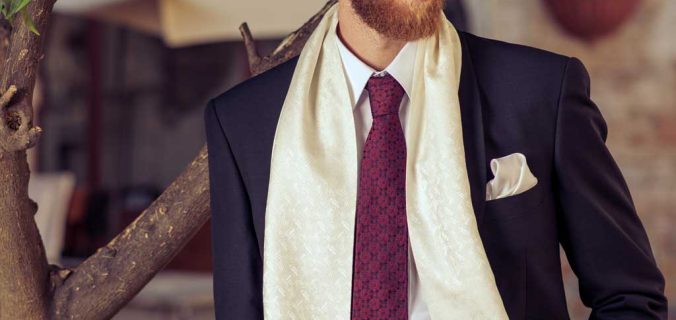Introduction
In the realm of professional attire, the suit stands as a timeless symbol of sophistication and elegance. However, adding a scarf to your suit ensemble can transform your look from classic to truly distinctive, infusing personality and panache into your professional wardrobe. Mastering the art of pairing a scarf with your suit requires understanding the balance of style, material, color coordination, and tying techniques. This guide delves into the nuances of elevating your professional style with a scarf, ensuring you make a statement that is both polished and practical.

Choosing the Right Scarf Material
The first step in incorporating a scarf into your suit ensemble is selecting the appropriate fabric. For formal or business settings, opt for materials that exude elegance and refinement, such as silk, cashmere, or fine wool. Silk scarves, with their smooth texture and lustrous finish, add a touch of luxury and are particularly suited for warmer months or indoor events. Cashmere and wool, on the other hand, provide warmth and comfort during colder seasons without compromising on style.
Matching Colors and Patterns
Color coordination is key when integrating a scarf into your suit outfit. A safe approach is to select a scarf that complements the dominant color of your suit. For instance, a navy suit pairs well with a scarf featuring shades of blue, grey, or neutral tones like beige or cream. If you’re feeling more adventurous, introduce a subtle pattern or color contrast to add visual interest, but ensure it doesn’t clash with your shirt or tie.
Patterns can also play a significant role in elevating your look. Consider a scarf with a refined pattern such as paisley, stripes, or a micro-check, ensuring it doesn’t overpower the rest of your outfit. When wearing a patterned suit or shirt, choose a solid-colored scarf to maintain a balanced appearance.
Tying Techniques for Different Occasions
The way you tie your scarf can completely change the vibe of your outfit. Here are three classic styles that work well with suits:
- The Parisian Knot: Fold your scarf in half lengthwise, drape it around your neck, and pull the ends through the loop created near your neck. Adjust the knot to sit neatly against your collar, providing a touch of European elegance.
- The Drape: Simply toss the scarf once around your neck, letting both ends hang freely down the front. This relaxed style works best with lighter fabrics and adds a casual flair to a suit, ideal for less formal occasions.
- The Once-Around Knot: Wrap the scarf once around your neck, cross the ends, and tuck them behind the loop. This style provides warmth without bulk and maintains a polished look suitable for formal settings.
Accessorizing Considerations
When wearing a scarf with your suit, consider the overall accessorizing strategy. If you’re also wearing a tie, ensure the scarf does not compete for attention; choose a thinner scarf and a simple knot. Avoid wearing large, statement necklaces or excessive pins that could clash with the scarf. A well-chosen pocket square in a complementary color can enhance the ensemble further, demonstrating a keen eye for detail.
Seasonal Adaptability
Adapting your scarf to the season is crucial for practicality and style. Lighter fabrics and brighter colors are more suitable for spring and summer, while thicker materials and darker hues are fitting for fall and winter. Experiment with different weights and textures to find what feels most comfortable and stylish throughout the year.

Versatility and Layering
One of the greatest appeals of incorporating a scarf into your suit look is the versatility it offers. Beyond its aesthetic contribution, a scarf serves as a functional layer, allowing you to adapt to changing temperatures indoors and out. During transitional weather or in overly air-conditioned spaces, a lightweight scarf can provide just the right amount of warmth without the need for a heavy jacket or overcoat.
Layering is key to achieving a polished yet practical ensemble. For cooler days, a scarf can be worn over a sweater or a vest under your suit jacket, adding depth and texture to your outfit. This layering technique not only enhances insulation but also introduces an element of depth and complexity to your style.
Cultural Significance and Personal Expression
Scarves hold cultural and historical significance across various regions, symbolizing everything from social status to military rank. By incorporating a scarf into your professional attire, you’re also tapping into this rich history, adding a touch of global sophistication to your look. Moreover, the scarf you choose can communicate aspects of your personality and cultural background, making it a powerful tool for personal expression in a professional context.
Choosing the Right Length and Width
The length and width of your scarf can greatly influence its wearability and the overall aesthetic it brings to your suit. Longer scarves offer more versatility in styling, allowing for multiple wraps or knots, while shorter scarves lend themselves to simpler drapes or neckties. A narrower scarf can be elegantly tucked into the jacket for a seamless look, whereas a wider one can be left open for a more dramatic effect.
When selecting the width, consider the scale of your suit and physique. A broader frame or a heavier fabric suit might call for a wider scarf to maintain balance, while a slender build or a lightweight suit would pair better with a slimmer scarf.
Maintaining Your Scarf
To ensure your scarf remains a valuable addition to your professional wardrobe, proper care is essential. Follow the care instructions provided, and if possible, hand wash delicate materials like silk or cashmere in cold water. Avoid machine washing or tumble drying, which can damage the fibers and affect the scarf’s appearance. Store your scarves neatly folded or rolled, away from direct sunlight to prevent fading.

Types of Scarves Suitable for Professional Attire
Before delving into styling techniques, it’s essential to consider the types of scarves that complement a suit and tie ensemble:
Cashmere Scarves: Known for their luxurious texture and warmth, cashmere scarves are an excellent choice for formal occasions. Opt for neutral colors like charcoal, navy, or camel to seamlessly integrate with your professional wardrobe.
Silk Scarves: Silk scarves exude elegance and are ideal for adding a touch of refinement to your outfit. Choose silk scarves with subtle patterns or classic prints like polka dots or paisley for a sophisticated look.
Wool Scarves: Wool scarves are versatile and provide excellent insulation. They come in various textures and patterns, making them suitable for both formal and business casual settings.
Essential Styling Tips for Wearing a Scarf with Your Suit
Choose the Right Length and Thickness: Opt for scarves that are long enough to drape comfortably around your neck without being too bulky. A width of 6-8 inches is generally ideal for achieving a balanced look.
Coordinate with Your Suit: Select a scarf color that complements your suit and shirt ensemble. For example, a charcoal suit pairs well with a navy or burgundy scarf, while a navy suit can be accented with a lighter gray or patterned scarf.
Understand Knotting Techniques: There are various ways to knot a scarf, each offering a distinct style:
- The Drape: Simply loop the scarf around your neck once, allowing both ends to hang evenly in front. This method is effortless yet polished, suitable for most professional settings.
- The Parisian Knot: Fold the scarf in half, drape it around your neck, and pull the loose ends through the looped end. Adjust the knot to sit comfortably on your chest, adding a touch of European flair to your attire.
- The Ascot Knot: Fold the scarf in half, drape it around your neck, then pull one end through the loop. Tuck the loose end under the scarf for a neat and sophisticated look, reminiscent of traditional British style.
Consider Fabric and Texture: The texture of your scarf can influence its overall appearance. Opt for smooth fabrics like silk for a sleek finish or choose textured wool for a more casual yet refined appeal.
Seasonal Adaptation: In colder months, prioritize warmth with thicker fabrics like cashmere or wool. During transitional seasons, opt for lightweight materials such as silk or cotton blends that offer comfort without overheating.
Additional Considerations for Professional Scarf Etiquette
Keep It Neat: Ensure your scarf is neatly arranged and free from wrinkles or creases. A well-maintained scarf reflects attention to detail and enhances your overall presentation.
Match with Other Accessories: Coordinate your scarf with other accessories such as a leather briefcase, belt, or watch strap to create a cohesive and polished look.
Experiment with Colors and Patterns: While maintaining a professional appearance is key, don’t be afraid to introduce subtle patterns or contrasting colors to add personality to your outfit.
Maintaining Your Scarf
To preserve the quality of your scarf:
- Follow Care Instructions: Different materials require specific care. Dry clean wool or cashmere scarves, while silk scarves may be hand-washed in cold water with a mild detergent.
- Store Properly: Hang scarves on a scarf hanger or neatly fold them in a drawer to prevent wrinkles and maintain their shape.
Conclusion
Integrating a scarf into your suit ensemble is an artful way to express your personal style while maintaining a professional image. By carefully considering the scarf’s material, color coordination, tying technique, and seasonal appropriateness, you can elevate your professional attire from standard to striking. Remember, the scarf should complement, not overwhelm, your suit, enhancing your appearance with a touch of sophistication and individuality. With these guidelines in mind, you’re ready to step out confidently, demonstrating that true style knows no bounds.
